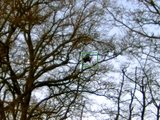RADA’s MHR supports ATHENA testing
RADA Electronic Industries’ Multi-Mission Hemispheric Radar (MHR) has supported testing of Lockheed Martin’s Advanced Test High Energy Asset (ATHENA) prototype laser weapon system at White Sands Missile Range, New Mexico, the company announced on 16 October.
The MHR was purchased by Lockheed Martin in 2015 and has been used since then in the development and testing of the ATHENA laser system.
During the testing the 30kW class ATHENA laser system brought down five 10.8ft wingspan Outlaw UAS. The MHR provided aerial surveillance, detecting aerial threats and cueing the ATHENA optics to the target.
The MHR is an S-Band, software-defined, Pulse-Doppler, active electronically scanned array radar with sophisticated beam forming capabilities and advanced signal processing. Compact and mobile, it is designed to deliver organic, tactical surveillance capabilities for force and border protection.
Related Equipment in Defence Insight
More from Digital Battlespace
-
![Chess Dynamics successfully demonstrates Vision4ce AI-driven tracker]()
Chess Dynamics successfully demonstrates Vision4ce AI-driven tracker
The Vision4ce Deep Embedded Feature Tracking (DEFT) technology software is designed to process video and images by blending traditional computer vision with artificial intelligence (AI) algorithms to present actionable information from complex environments.
-
![Wave Relay devices cleared for security use on commercial systems in industry trend]()
Wave Relay devices cleared for security use on commercial systems in industry trend
Persistent Systems has been cleared by National Security Agency (NSA) to transmit sensitive data on commercial networks. The devices are added to the NSA’s Commercial Solutions for Classified (CSfC) component list which also includes other companies’ products providing the same security.
-
![UK teases cyber spending boost in Strategic Defence Review ahead of “imminent” release]()
UK teases cyber spending boost in Strategic Defence Review ahead of “imminent” release
The release of the UK’s Strategic Defence Review (SDR) has been long promised as mid-year. It is possible it could be as early as 2 June although the UK Ministry of Defence (MoD) continues to play its cards close to its chest.
-
![Intelsat emphasises SATCOM resilience for SOF in contested domains (video)]()
Intelsat emphasises SATCOM resilience for SOF in contested domains (video)
Intelsat outlines how its multi-orbit SATCOM architecture is enhancing connectivity and resilience for special operations forces operating in degraded and contested environments.
-
![US Space Force’s next-generation missile warning system moves forward with $500 million in new contracts]()
US Space Force’s next-generation missile warning system moves forward with $500 million in new contracts
Next-Generation Overhead Persistent Infrared (Next-Gen OPIR) satellites are intended to provide early warning of missile launches from any location worldwide and new ground stations will result in expanded coverage of critical missile warning.























